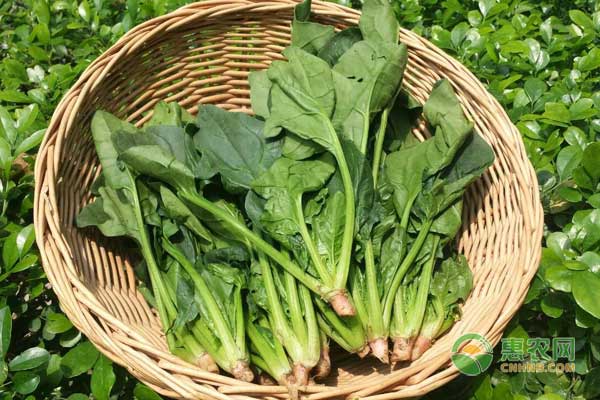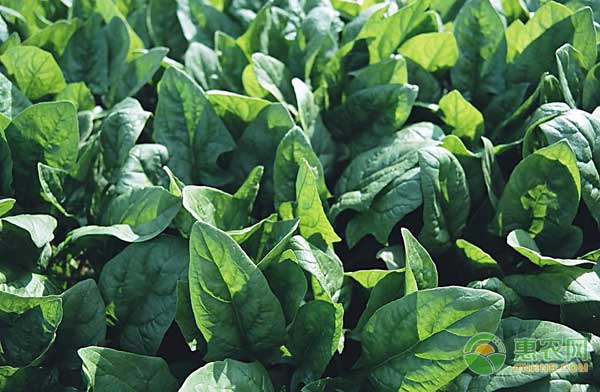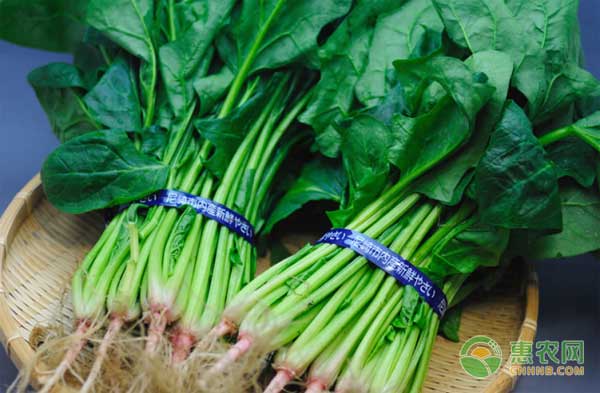Spinach anniversary cultivation technology full version (recommended collection)
Spinach is one of the most common vegetables on the market. It has high nutritional value and is rich in vitamins, minerals, carotene and so on. Spinach is widely adaptable and cultivated in both the north and the south of China. It is a vegetable that can be grown all year round. Spinach has strong cold tolerance and can withstand low temperatures below 0 °C. The open field can be cultivated in winter. Spinach grows rapidly, has a short growing season, high multiple cropping index, high investment and high yield, and simple management technology. As long as scientific cultivation techniques are adopted, suitable varieties are selected, and the sowing date is adjusted reasonably, annual cultivation can be realized. 1 Environmental requirements of the place of origin It is advisable to choose flat terrain, convenient drainage and irrigation, deep soil layer, loose and fertile soil, good physical and chemical properties, and no sandy loam or sticky loam land for sugar beet and spinach in the first 2 to 3 years. The forehead can be beans, melons, and peppers, and grain or cash crops can be selected. The production site should be far away from the pollution source, there is no industrial “three wastes†within 3 km, and there are no pollution sources such as large livestock farms. 2nd anniversary of the mouth 1 Spring cultivation will be planted in stages from mid-February to late-April in February, and will be harvested from late April to late June. 2 Summer cultivation will be planted in stages from early May to mid-July, and will be harvested from late June to mid-September. 3 Autumn cultivation will be planted in stages from early August to late October, and will be harvested from late September to late December. 4 wintering cultivation will be planted in successive stages from mid-November to late January, and will be harvested from late January to late February. Among them, spring from March to April and autumn from September to October are the most suitable season for spinach growth. 3 variety selection Spinach cultivated in spring and winter should be selected from varieties with strong cold tolerance, resistance to convulsions, disease resistance, high quality, high yield, strong resistance, high yield and good quality; spinach cultivated in summer and autumn should be selected for rapid growth, heat resistance and resistance. Disease, high quality, high yield, resistance to convulsions, strong resistance, high yield and good quality. Common cultivars in Shanghai include green leafy spinach, Hercules, Fumei, Lvbao, Husong No. 1, Qiangsheng, Taisheng and Husong No. 5. 4 Site preparation Spinach has a high yield, a long harvest period, and a large amount of fertilizer, especially nitrogen and phosphate fertilizers. Therefore, the base fertilizer should be applied before the preparation of the soil. After the harvest, the leaves of the previous crops are removed in time, and the soil is deepened and the soil is matured. When the soil is prepared, the organic fertilizer is applied at 3 000~5 000 kg/667 m2, and the special compound fertilizer for nitrogen, phosphorus and potassium vegetables is applied 50 kg/667 m2. The amount of fertilizer can be adjusted according to the growth period and soil fertility. The base fertilizer is mainly spread, and it is 15~25 cm deep. After fertilization, the soil is deep and flat, and it is suitable for sorghum cultivation in winter and spring, and flat cultivation in summer and autumn. The height is 0.15~0.20 m and the width is 1.20~1.50 m. 5 germination sowing 5.1 Seed germination Spinach seed coat is thicker, water and air are not easy to enter. If the seed is not treated before sowing, the seed is slow and uneven after sowing. Especially in summer and autumn, when planting in the hot season, the seed germination rate of dry seeds is extremely low. In order to speed up the emergence of seedlings and maintain the same growth period, the method of soaking seeds and germination is usually adopted before sowing. Planting and cultivating in spring from March to April and autumn from September to October can not be soaked and germinated, and can be germinated in order to speed up the emergence of seedlings. The specific soaking and germination methods are as follows: First select the selected seeds, soak them with 50% 84 disinfectant for 15 min, rinse with water; soak the seeds with warm water at 55 °C for 30 min, stirring constantly; then soak the seeds with water and put them in a refrigerator at 4 °C for 12 h, water Rinse off; then place at 15~20 °C for germination, 24~48 h to reveal white. 5.2 Seeding method Most of the spinach cultivation is carried out by live broadcast, which is mainly spread and broadcast, and can also be mechanized. 1 to 2 weeks before sowing, the surface water is poured into the surface; 3 to 4 days before sowing, 667 m2 is applied to the surface with 5% phoxim granules 4~5 kg and shallowly poured into the soil for soil treatment. Tigers, crickets and other underground pests, then flatten the noodles. Before the sowing, ditch and pour the bottom water, the row spacing is 8~10 cm, and the ditch depth is 3~4 cm. After the seeding, the soil is covered and compacted, and the soil is covered with a thickness of 1~2 cm. After spreading, the soil is not covered with soil. Generally, the planting amount in spring is 3~4 kg/667 m2, and the seeding rate in high temperature and wintering is 4~5 kg/667 m2. For multiple harvesting and wintering cultivation, the seeding amount should be increased appropriately, which can be increased to 8~9 kg/ 667 m2. Keep the soil moist after sowing. Spinach is sown in summer and autumn. Cover it with straw or cover it with a small arch shed to prevent high temperatures and direct sunlight. Watering should be carried out in the morning and evening, or watering with micro-spraying, can not be poured, often keep the soil moist, 6 to 7 days after the seedlings. If the winter and spring sowing spinach is planted later, and the temperature is low, the plastic film or shade net is covered on the seedling hoe to promote the seedling, and the seedling is removed after emergence. In addition, summer and autumn spinach can also be planted by post-emergence transplanting, and can avoid high temperature or low temperature season in the early stage. The germinated seeds were sown in 72-well trays and colonized in 5 to 6 true leaves. In general, summer should be transplanted on cloudy or evening. Before transplanting, the seedbed should be watered to make the roots of the seedlings more soil. When transplanting in the field, it should be planted shallowly, and water should be poured in time after planting. The temperature in summer and autumn will be high. Watering will be done once in the morning and evening, and it will take 3~5 days to survive. The plant spacing is 8~10 cm, the row spacing is 15~20 cm, and the planting density is 30 000~40 000 plants/667 m2. 6 Field management 6.1 Temperature Management Spring and winter spinach should be covered with plastic film when the temperature is low, which can be directly covered on the surface of the clam, or covered with a small arch. When directly covering, the film is removed after the spinach is emerged or replaced by a small arch. Pay attention to the small arch shed to expose the night cover, and clear the rain cover. When planting summer and autumn spinach, cover the sunshade net before and after emergence, clear the cover and expose it, and cover it early to cool down. 6.2 Water Management In the early stage of spring and winter cultivation, water is properly controlled, and the amount of water is increased in the later stage to keep the soil moist. After sowing in summer and autumn, it should be lightly poured and watered to keep the soil moist and reduce the soil temperature. The soil is kept moist during the growth period, and the soil water content is 60% to 70%. The hydration can be sprayed or furrowed, and the water surface is 2 cm below the surface. Watering at high temperatures should be carried out at morning and evening, and watering at low temperatures should be carried out at noon. During the rainy season, you should pay attention to ditch drainage and keep the water in the field. When the humidity is high, ventilation should be increased to prevent downy mildew. Generally, after 3 to 4 days of sowing, the first water is poured, and 2 leaves and 1 heart are poured for the second time. 3~4 tablets of true leaves (plant spacing 5~8 cm, row spacing 15~20 cm), watering the third time, combined with intercropping and topdressing, can be used for top dressing with 0.5%~1.0% urea solution. In the future, depending on the growth of the plant, the fertilizer will be topdressed 1 or 2 times, and each time the urea is applied 5~7 kg/667 m2, and the top dressing interval is 10-15 days. When integrated with water and fertilizer, the organic liquid fertilizer with higher nitrogen content should be sprayed according to the growth of the plant. Stop watering 3 to 5 days before harvest. 6.3 cultivating and weeding Weeding and weeding according to the growth of weeds. For the use of strips, shallow cultivating and weeding should be carried out between the sowing rows, and then weeding and weeding should be carried out 1 or 2 times according to the growth of weeds. 7 Pest Control The main disease of spinach in Shanghai is downy mildew; the main pests are aphids and leaf miners, etc. In summer and autumn cultivation, attention should also be paid to the prevention and control of underground pests such as tigers and crickets. The prevention and control strategy is based on comprehensive agricultural control and supplemented by drug control. The comprehensive prevention and control method of downy mildew agriculture is to insist on reasonable arrangement of rotation, clean the pastoral, and select resistant varieties; master the seeding amount when planting, moderately planting, ensure the ventilation and light transmission in the field; ensure the supply of water and fertilizer, cultivate strong seedlings, and strengthen the plants. Disease prevention and disease resistance, reduce the probability of disease occurrence; timely remove the weeds around the pastoral and remove the yellow plants. The integrated pest control technology uses physical control methods such as insecticidal lamps and yellow plates. Chemical control should choose low toxicity and low residue pesticides. Downy mildew can be treated with 75% chlorothalonil milk 600 times solution, 50% methyl thiophanate (methyl thiophanate) WP 500 times solution or 50% carbendazim WP 700 times solution spray, every 7 Spray once every 10 days, and spray continuously for 2~3 times. The leaf miner can choose 75% chlorpyrifos wettable powder 2,000~3 000 times liquid control; the mites can use 36% acetamiprid water dispersible granules 5,000~6 000 times liquid or 25% thiamethoxam water dispersible particles 2 500~3 000 times liquid control. Ground tigers, cockroaches, etc., were applied to the noodles with 5% phoxim granules 4~5 kg/667 m2. 8 timely harvest Stopping the application of nitrate-containing fertilizer for more than 2 weeks before harvesting and spraying 1~2 times of ammonium nitrogen fertilizer can effectively reduce the oxalic acid content in spinach. When the plant grows to a height of 20~25 cm, it can be harvested. When harvesting, it will be cut along the ground with a knife and keep the root of 1~2 cm. After harvesting, remove the outer leaves, yellow leaves, diseased leaves, residual leaves and damaged leaves, remove the unqualified spinach, and then clean the mud, impurities, bulk or bundled to market. The above is the annual cultivation technology of spinach, and it is hoped to provide reference for the majority of growers. As a common vegetable, spinach is stable in the market, and spinach can be used to obtain stable economic benefits. Another benefit of vitamins for the human body is that it can help the growth and development of the human body to operate normally, especially for teenagers, vitamins are one of the essential nutrients in the growth process. For example, vitamin D can well adjust the metabolism of some trace elements in the human body, and can also promote the absorption of calcium by the human body, maintain bone health, and maintain a balance between the blood phosphorus level and the blood calcium level in the human body. Vitamin Efficacy,vitamin drink,The benefits of vitamins,vitamin water YT(Xi'an) Biochem Co., Ltd. , https://www.ytwholefood.com

